
|
Astronomy Picture Of the Day (APOD)
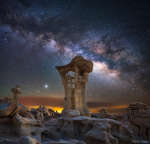 APOD: 2020 August 13 B Jupiter and Saturn Rising Beyond Alien Throne Rock
APOD: 2020 August 13 B Jupiter and Saturn Rising Beyond Alien Throne Rock
13.08.2020
Whatbplanets are those behind that unusualbrock spire? Saturn (lower left) and Jupiter.b This month, after sunset, the bright planetary duo are quite prominent toward the southeast.b Now your view of our Solar...
 The Shifting Tails of Comet NEOWISE
The Shifting Tails of Comet NEOWISE
12.08.2020
Keep your eye on the ion tail of Comet NEOWISE. A tale of this tail is the trail of the Earth. As with all comets, the blue ion tail always points away from the Sun. But as Comet C/2020 F3 (NEOWISE) rounded our Sun, its ion tail pointed in slightly different directions.
 Churning Clouds on Jupiter
Churning Clouds on Jupiter
11.08.2020
Where is Jupiter's ammonia? Gaseous ammonia was expected to be seen in Jupiter's upper atmosphere by the orbiting Juno spacecraft -- but in many clouds is almost absent. Recent Juno data, however, gives some clues: some high-level clouds appear to be home to an unexpected type of electrical discharge dubbed shallow lightning.
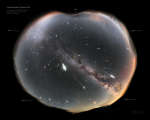 Perseids from Perseus
Perseids from Perseus
10.08.2020
Where are all these meteors coming from? In terms of direction on the sky, the pointed answer is the constellation of Perseus. That is why the meteor shower that peaks tomorrow night is known as the Perseids -- the meteors all appear to came from a radiant toward Perseus.
 The Origin of Elements
The Origin of Elements
9.08.2020
The hydrogen in your body, present in every molecule of water, came from the Big Bang. There are no other appreciable sources of hydrogen in the universe. The carbon in your body was made by nuclear fusion in the interior of stars, as was the oxygen.
 Crescent Saturn
Crescent Saturn
8.08.2020
From Earth, Saturn never shows a crescent phase. But when viewed from a spacecraft the majestic giant planet can show just a sunlit slice. This image of crescent Saturn in natural color was taken by the robotic Cassini spacecraft in 2007.
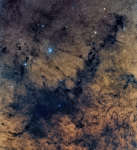 The Pipe Nebula
The Pipe Nebula
7.08.2020
East of Antares, dark markings sprawl through crowded star fields toward the center of our Milky Way Galaxy. Cataloged in the early 20th century by astronomer E. E. Barnard, the obscuring interstellar dust clouds include B59, B72, B77 and B78, seen in against the starry background.
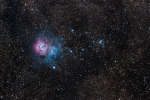 Messier 20 and 21
Messier 20 and 21
6.08.2020
The beautiful Trifid Nebula, also known as Messier 20, is easy to find with a small telescope in the nebula rich constellation Sagittarius. About 5,000 light-years away, the colorful study in cosmic contrasts shares this well-composed, nearly 1 degree wide field with open star cluster Messier 21 (right).
 APOD: 2020 August 5 B Picture Rocks Sun Dagger
APOD: 2020 August 5 B Picture Rocks Sun Dagger
5.08.2020
Ancient sun daggers will not hurt you, but they may tell you the time.b A sun dagger is a dagger-shaped gap in a shadow created by sunlight streaming throughba crevice in a nearby rock.
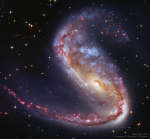 APOD: 2020 August 4 B NGC 2442: Galaxy in Volans
APOD: 2020 August 4 B NGC 2442: Galaxy in Volans
4.08.2020
Distorted galaxy NGC 2442 can be found in the southern constellation of the flying fish, (Piscis) Volans. Located about 50 million light-years away, the galaxy's two spiral arms extending from a pronounced central bar have a hook-like appearance in wide-field images.
|
January February March April May June July August September October November December |
|||||||||||||||||||||||||||||||||||||||||||||||||